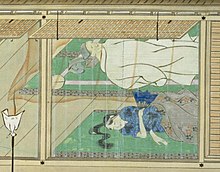Futon

Futons are traditional Japanese bedding. A futon is a padded mattress, called a shikibuton, a quilt, called a kakebuton, and a pillow filled with beans, called a makura.[1] The futon was put on the floor at night for sleeping. They could be easily rolled up during the day when they were not needed.[2] The word futon has come to mean a lot more than this. Although many Japanese people sleep in a bed, they say "I sleep on futon"; it means to go to bed. Futon now means things that Japanese people sleep on, including beds.
Types of futon[change | change source]
Many companies make futons, and there are many kinds of futons. Futons are made from chemical fibers like polyester, natural fibers like cotton, feather, down and wool. Japanese quilts usually contain feathers and Japanese mattress usually contain wool.
The Japanese quilt can keep in heat and moisture, depending on what it is made from. Usually, a futon that includes over 50% hemp or cotton is called a Menfuton. This is popular all over the world. Futons made from down are called quilt down. This retains heat, so this is a high-class futon. Futons made from feathers are called comforters. This is cheap and is common around the world. Futons made from chemical fibers are called chemical fiber futons. This is cheap so this is popular. Futons made from wool are called Yomo futon. These are warm.
In winter, people generally use Hadafuton like a blanket to keep warm. In summer, people generally use Towelket like a big towel or Seer quilt which are cooler.
Futons are generally used with a futon cover, because these make it easy to keep the futon clean. People generally use futons so they can sleep comfortably, stay warm and support their bodies while asleep. People usually sweat during sleep, so futons absorb sweat and collect moisture. Futons have to be hung out in sunlight to keep them dry, this is called futon-hoshi.[1] If this is not done, mites and mold could grow on the futon and it will become dirty and unsanitary. Futons need to be looked after properly.
History[change | change source]

In the 14th century, most people slept on straw mats, but the nobles slept on tatami. These were not as soft as futons are now. It was said that they were hard and uncomfortable. For a very long time, people covered themselves with their clothes to keep warm. Most people slept nude. Rich people never did such things.
In the 17th century, bedclothes were made. People made it by stuffing cloth with cotton and wool. These bedclothes are the original form of the futon.
In the 18th century, futon production started (because there was more domestic cotton available[3]). At that time, futons were too expensive to buy for average people. They could cost 1,200,000 yen. Futons were important gifts and many men gave them to women in order to seduce them. Prostitutes were sometimes presented with futons by rich men. Prostitutes could be ranked by counting the futons; the higher ranks of prostitutes received more futons.
In those days, futon meant a mattress, not a quilt. For a quilt, people commonly used yogi (よぎ, literally "nightclothes"). Yogis are kimono-shaped bedclothes. In the Kansai area, they used a square thing like a blanket, a fusuma. The quilt is said to have evolved long before it.
In the 19th century, most people were able to buy futons. The import of the raw cotton began, and many factories were built. Because of industrial development, making futons was easier and more efficient than before. This made the price become down and people were able to afford them.
Modern futons[change | change source]
Some new futons today are inflatable. People use pillows on futons now.
Other websites[change | change source]
- How to look after a Japanese futon Archived 2009-04-23 at the Wayback Machine.
References[change | change source]
- Futon iyoho site. Ofutonnohito. Retrieved on 13 May 2009.
- Matsumoto, Yousuke(2008). Seikatsu Handbook. Daiichigakusyuusya, Tokyo. p. 64.
- Inside Japan. NISHIKAWA LIVING web. NISIKAWA LIVING Inc. 27 May 2009.
- Sagami web. Retrieved on 3 June 2009.
- Futonnorekishi. Retrieved on 12 May 2009.
- ↑ 1.0 1.1 Mishima, Shizuko. "Traditional Japanes Futon". Japan Travel. About.com. Archived from the original (htm) on August 3, 2009. Retrieved August 25, 2009.
- ↑ "Japanese furniture". Living in Japan. Retrieved 2009-08-25.
- ↑ Dusenbury, Mary (1992). "A WISTERIA GRAIN BAG and other tree bast fiber textiles of Japan". Textile Society of America Symposium Proceedings. Retrieved 12 June 2021.
